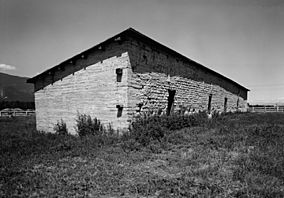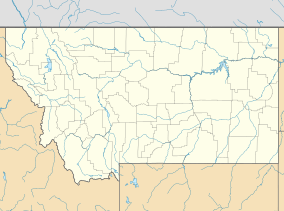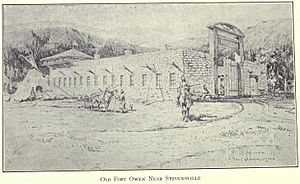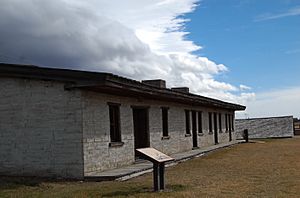Fort Owen State Park facts for kids
Quick facts for kids Fort Owen State Park |
|
|---|---|

Barracks at Fort Owen, the only original structure still standing
|
|
| Location | Stevensville, Montana, United States |
| Area | 1 acre (0.40 ha) |
| Elevation | 3,291 feet (1,003 m) |
| Designation | Montana state park |
| Established | 1960 |
| Visitors | 4,612 (in 2023) |
| Administrator | Montana Fish, Wildlife & Parks |
| Website | Official website: https://fwp.mt.gov/stateparks/fort-owen |
Fort Owen State Park is a special historical place in Montana, United States. It's located just outside the town of Stevensville, Montana. The park is named after Fort Owen, which started as a mission and later became a busy trading post. It was built in 1841 and named after a trader named John Owen.
The park is about one acre (0.40 ha) in size. It sits at an elevation of about 3,293 feet (1,004 m) above sea level. The Montana Department of Fish, Wildlife and Parks owns and manages this important site. Many people call Fort Owen the "cradle of Montana civilization" because so many important "firsts" happened here.
Contents
Discovering Fort Owen's Past
Fort Owen State Park has a long and interesting history. It began as a mission and grew into a key trading post. This area saw the very first European settlements and farming in Montana.
=The First St. Mary's Mission (1841)
On September 24, 1841, a Catholic priest named Pierre-Jean De Smet arrived in the Bitterroot Valley. He was with other priests and brothers. They built a small Catholic chapel called St. Mary's Mission. This was the exact spot where Fort Owen State Park is today.
Father DeSmet used this mission as his base. From here, he worked with the Bitterroot Salish tribe of Native Americans. This mission was the first permanent white settlement in Montana. It was also the first Christian church and the first Catholic church in the area. The wagons and oxen Father DeSmet brought were the first ever in Montana.
By winter, they had built several houses, a trading post, and shops. In the spring of 1842, Father DeSmet planted the first oats, potatoes, and wheat. He also planted the first garden plants. Historians say this was the first farming in Montana. In the summer of 1842, cows arrived from Fort Colvile. These were the first domesticated cattle in Montana.
Another priest, Father Antonio Ravalli, joined the mission in 1842. By the end of that year, the priests had built Montana's first sawmill, first grist mill, and first school. Because of all these important beginnings, St. Mary's Mission and Fort Owen are known as the "cradle of Montana civilization."
=John Owen's Trading Post (1850)
Around 1850, attacks from the Blackfeet tribe caused the original St. Mary's Mission to close. (A different church, also called St. Mary's Mission, was built nearby in 1866. That building is still standing today.)
John Owen, a civilian who supplied goods to soldiers at Fort Hall in what is now Idaho, moved to the Bitterroot Valley. He bought the land where St. Mary's Mission stood for $250. This was the first time land was officially bought and sold in Montana.
Owen renamed the site Fort Owen after himself. He and his wife, Nancy, who was a full-blood Shoshone woman, ran the fort. It became a very popular trading post and a place for travelers to rest. Fur trappers, traders, missionaries, and explorers all stopped there.
The priests had told Owen to burn the chapel if they didn't return in two years. Owen followed their instructions. Today, the river has changed course, and the exact spot of the original mission is hidden.
Gold Discovery and Owen's Role
In 1852, John Owen found gold in the Bitterroot Valley. This discovery brought many new settlers to the area. In 1856, Owen became an Indian agent for the U.S. government. His job was to work with Native American tribes. He served until 1862. He resigned because he disagreed with how some people treated the Salish tribe, especially regarding certain goods. For a while, Fort Owen was even the main Indian agency for the area.
In 1860, Owen made big improvements to the fort. He replaced its wooden walls with strong adobe brick walls.
Challenges and Decline
Nancy Owen passed away in 1868. After this, John Owen faced personal challenges. Fort Owen started to become less popular. Fewer people visited because of continued challenges from the Piegan Blackfeet and Owen's personal difficulties.
When the Mullan Road opened in May 1864, it bypassed Fort Owen. The new road went through Hell Gate, Montana, to the north. This made Fort Owen's money problems even worse.
In 1872, Fort Owen was sold at an auction to Washington J. McCormick. Owen owed McCormick money. McCormick continued to run the saw and grist mills at the site. In 1889, he was fixing the fort's roof when a strong wind ripped it off. McCormick was thrown to the ground and died.
After McCormick's death, Fort Owen was owned by several local farmers and ranchers. Eventually, the old fort was given to the Stevensville Historical Society. In 1937, the historical society donated what was left of the fort to the state of Montana.
Fort Owen State Park Today
Fort Owen State Park is located on the Stevensville Cutoff Road. It's south of Missoula, Montana, near U.S. Route 93.
Not much of the original Fort Owen remains today. The only building still standing is the East Barracks. The back wall, part of the side walls, and the inside walls are made of the original adobe bricks. These bricks were made and put up by Father DeSmet and his team in 1841 and 1842.
From 1957 to 1980, archeologists from the University of Montana studied the site. They uncovered the fort's foundations, which visitors can see. You can also see rebuilt versions of an 1850s cabin, a root cellar, and a well house.
Fort Owen State Park is a one-acre (0.40 ha) piece of land. It is surrounded by private property and is open every day of the year. Sometimes, volunteers from the Stevensville Historical Society are there to answer questions. Most visitors use signs around the park to learn about the mission, the fort, and their history.




